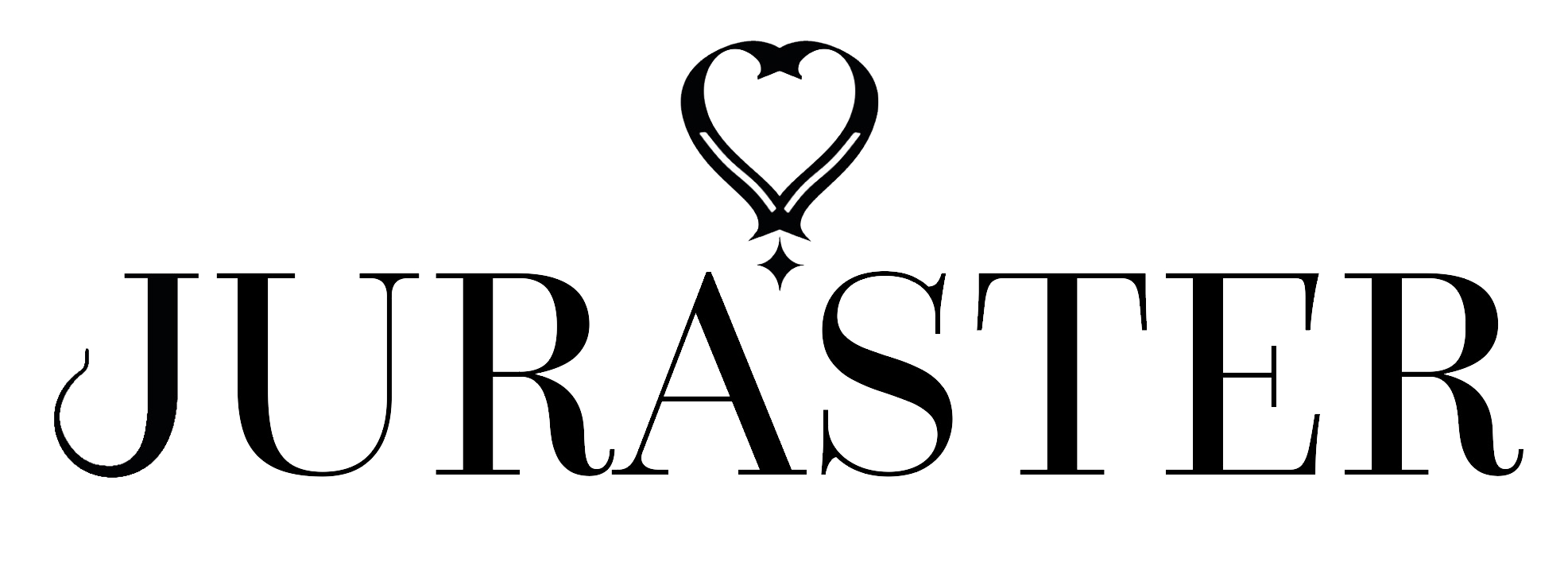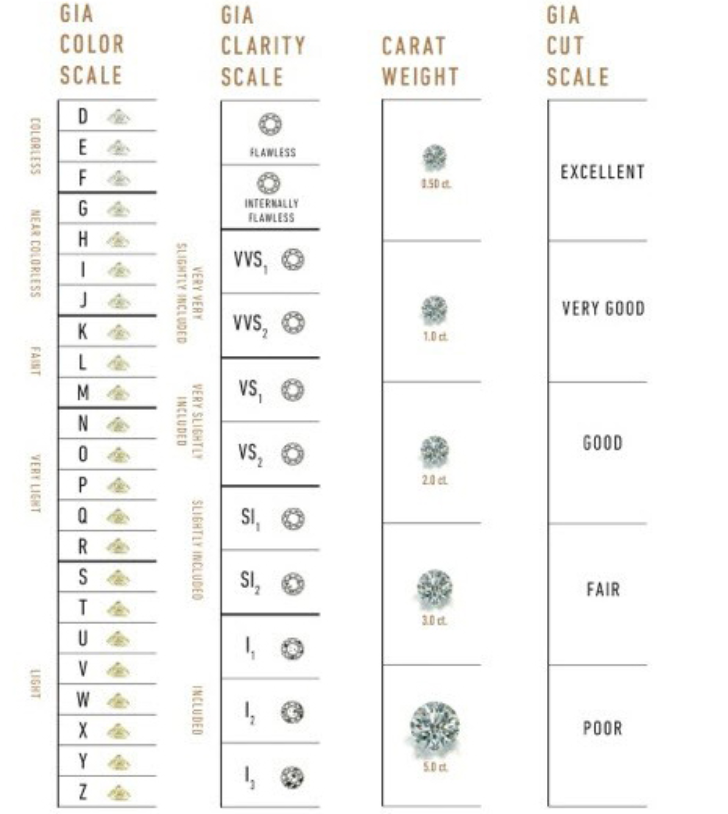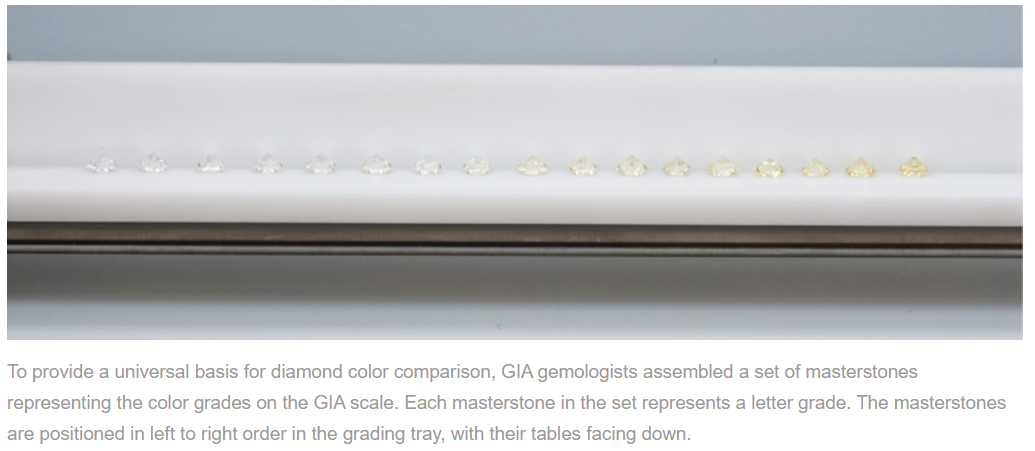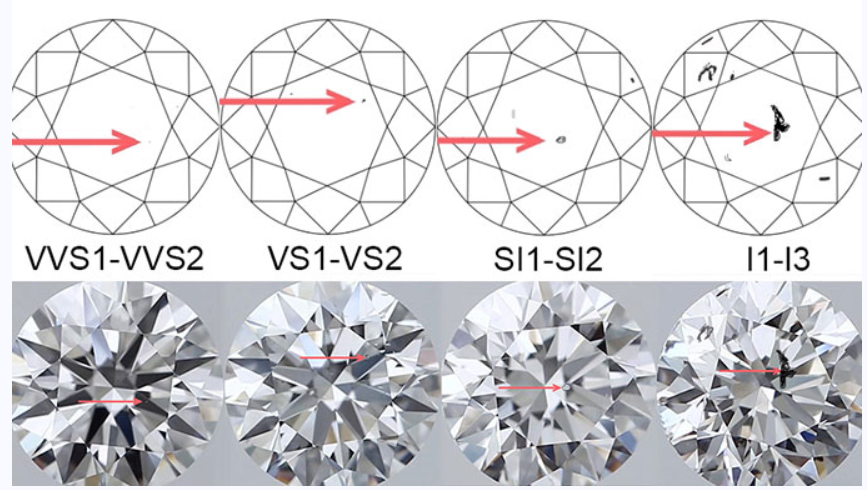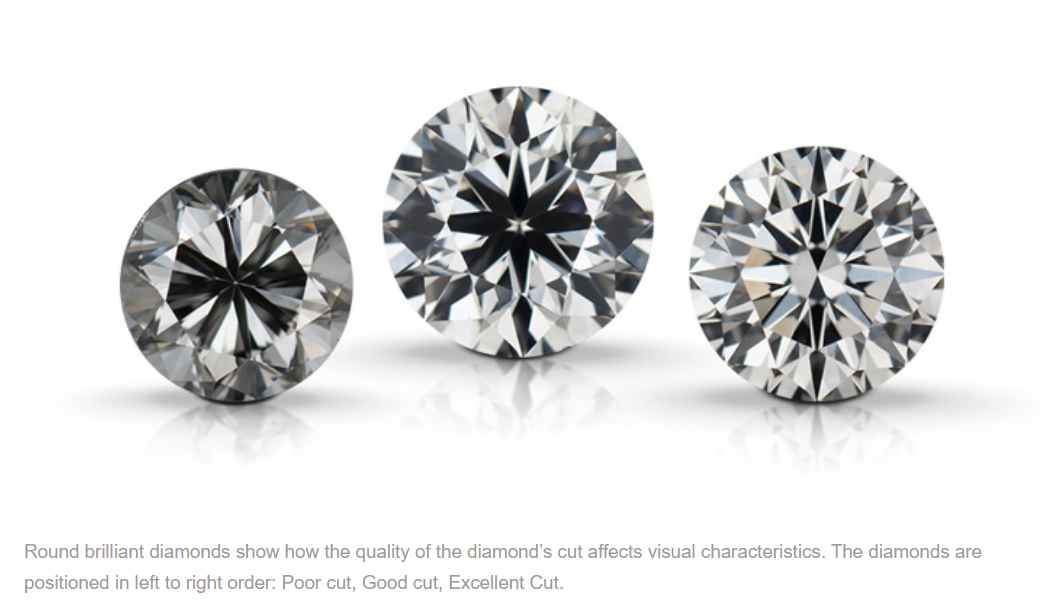Masterclass: buying Diamond Rings

All about Diamonds
If we had a pound for every time we’ve been asked “how much does a diamond cost?” well, we’d have a tall stack of pounds.
It’s frustrating to not be able to answer this question clearly. However, it’s a bit like asking someone, how much does a home cost? Like anything, it’s to do with size, quality, availability and personal taste. Very roughly, as a rule of thumb, a round brilliant cut diamond that is 3/4 carat (ct) is about £4,500 plus the mount, yet one marginally bigger at 1 ct in weight and of the same good commercial quality will currently cost around £10,000 plus the mount. So size does matter! You can spend much less or much more depending on what carat weight, and category of colour, clarity or cut the diamond is. (prices as per Nov 20)
A bit of knowledge on the subject helps here, because understanding how diamonds are categorised and therefore valued, will help inform your purchase; but first just forget the idea of spending 3 months’ of your salary on an engagement ring. We think this formula was spun by De Beers when they created the American market after World War II, and it needs to be dumped. Just have a realistic and comfortable sum and never feel you should spend more if you can’t. That way you will enjoy investing for the long term.
Just dwell on this amazing thought before we dive in - each diamond you gaze at was formed 1 - 3.5 billion years ago from molecules of carbon trapped about 150 km under the earth’s surface, at 1200 degrees Celsius, at a pressure of 5 thousand times greater than our normal atmosphere (that’s the equivalent of the whole of the Empire State building, compressed on top your foot) and then was blasted to the surface of the earth in a cataclysmic volcanic eruption. The very existence of diamonds at all is a serious freak of nature. You can read more about their extraordinary genesis here.
Anyway, let’s return to the point and some technical knowledge. Diamonds are an international commodity and the biggest market is in the US, consequently an international diamond grading system was initiated over 30 years ago by the Gemological Institute of America – GIA – which harmonized various methods and simplified terminology to avoid localised market based grades and obsolete descriptors like First Water, Blue White, Top Silver Cape etc. All quality diamonds above 1/3 carat will most likely be accompanied by a grading report certificate by the GIA (although other labs are available). The GIA terms these the 4 Cs. As they affect the quality/cost factors of diamonds, these are:
Rarity & The 4 Cs: Carat, Colour, Clarity and Cut
Carat – the unit of weight for all precious stones is a carat. One carat (ct) is 200mg – the average weight of a raindrop. Vast quantities of rock are moved for each diamond found, often 100 tonnes per 5cts of rough found, that’s 7 solid double decker bus amounts of rock for a tiny amount of crystallised carbon. In any case, most are industrial quality – only 1 in 3 diamonds found is used in jewellery, and only 1 in 6 is a gem good enough for fine jewellery; the rest is used in industry for cutting tools. Considering that the average rough diamond weighs less than 1.10ct when it’s mined, and it will lose over half its weight in cutting, consequently only a minute amount of stones, 0.01% of rough diamonds will yield a finished stone larger than 1ct and you can see why diamonds are so expensive the bigger they get. The difference in diameter is very slight, however: a brilliant round cut diamond of 0.50ct measures 5.2mm, 1ct measures 6.5mm diameter, 2ct measures 8.2mm, even 5ct measures 11mm so it’s not that enormous to look at despite the value.
Colour – most diamonds have a yellowy-browny body colour, due to varying amounts of nitrogen atoms within the carbon crystal when it formed, so finding diamonds without this tint is very rare. In diamond terms, colour is measured on an alphabetical scale starting at D not A (note the idiosyncrasy – D for Diamond, and it replaced another grading system which used A thus avoiding confusion). Diamonds graded for colour are placed table down on a white card and viewed through the thickest part of the stone under ‘north’ white light alongside known master stones. A grade D diamond’s body colour is completely colourless, and the scale runs through from D to Z. Face up, diamond colour is very hard to judge thanks to its vibrant brilliance and fire, however, a diamond is clearly tinted to the untrained eye at about K. Fancy vivid coloured diamonds, like pink, blue, green and orange, are a realm of rarity altogether and categorised in a different way.
Back to the 4 C’s and we are at C for Clarity. This refers to the presence and number or type of tiny natural features called ‘inclusions’ inside the stone or on the surface, which can be found with examination under 10x magnification. From what you know now about the birth of diamonds, it’s really not surprising there are any ‘flaws’. As it grew, there could have been little slips in the regularity of the crystal lattice, or voids, or sometimes tiny crystals of other mantle minerals incorporated into the diamond crystal, such as garnet. The old wives’ tale of there being little flecks of coal is cure but not true! When the naked or untrained eye can see something that detracts from the stone’s beauty eg black or white marks in the middle, which affect its ability to sparkle this is a serious issue and at the other end of the scale, a diamond that is perfectly free of any inclusions is almost unbelievably rare and therefore expensive. Most diamonds have something an expert will spot. Given a good grade of cut, if you are hung up over deciding between clarity or colour, invest in colour as this is more easy to judge for non-experts.
The 5 steps in grading for diamond clarity run:
F or IF = Flawless, or Internally Flawless
VVS = Very Very Slightly Included, levels 1 & 2
VS = Very Slightly Included, levels 1 & 2
SI = Slightly Included, levels 1 & 2
I = Included, levels 1, 2 & 3
Cut – the shape of the stone, and the expertise and quality of its symmetry and polish. An optical measuring device is used to determine the diamond’s proportions, measurements, and facet angles. Given that by far the most popular cut and shape is the round brilliant cut, this is also the most highly prized. There are 57 facets cut onto a brilliant cut, which should all be perfectly angled to release maximum sparkle and brilliance – what we call fire. Oval and cushion shape diamonds used to be considerably cheaper but now are so fashionable, they have gained in price. Princess-cuts, first designed in the 1960’s, combine a square outline with the brilliant cuts’ multi-facets. If you are a purist and prefer your ice cool, then baguette, octagonal, or Asscher cut diamonds are serene and more lustrous than their sizzling sparkling sisters, and are also less expensive per carat. However, whatever the shape, if a stone is poorly cut with mismatched angles and/or facet edges, or polished badly, then its sparkle isn’t so well defined, and this detracts from the diamond’s innate beauty. No point having a top colour, flawless, large diamond if it underwhelms the admirer with a dull ‘fish-eye’ and lack of sparkle due to poor cutting proportions or wonky symmetry.
The 4 Cs are really the 4 Considerations. Which are the most important to you, what would you compromise on? Get the best quality you can for your budget, that way you know you will be buying well for the long term.
Treatments – any treatment or "enhancement" made to a diamond lowers its value. All diamond reports will comment on any treatments commonly used to improve a diamond eg laser drilling and subsequent fracture filling. We do not recommend that you buy such diamonds. We do not sell diamonds that have been treated in any way. While laser drilling and fracture filling are used to improve a diamond's clarity, high pressure / high temperature (HPHT) treatments are used to improve colour by removing brown colorations from the diamond. HPHT involves placing the diamond in a pressure vessel and applying extremely high pressure and temperature. This environment mimics the conditions the diamond crystal was originally formed under. The effects of HPHT are permanent. Labs such as GIA will certify a HPHT diamond, but will note the presence of the treatment on the diamond's report. We do not sell diamonds that have been treated by HPHT.
Diamond Report - As previously mentioned most gem diamonds that weigh over 0.30ct will have an impartial Diamond Grading Report Certificate to look at and discuss when you are considering what diamond to buy. You’ll be handed this report to keep with the diamond when you make your purchase. Keep it safe as it costs a fortune to certificate and can’t be duplicated. The most popular and widely recognised lab reports are from the GIA (Gemological Institute of America) however other labs are available.
Ethics – We deal with reliable diamond merchants who we know are committed to the best ethical practices and so if we have supplied you with diamonds, your invoice from us will state that the diamonds supplied were handled in accordance with the Kimberley Process Certification Scheme (KPCS) which ensures that the rough originated from countries or mines not involved in conflict. Having been working in the industry for over 30 years, we have forged many personal relationships with diamond merchants based on fair dealing and mutual trust, and we try to go beyond the measures imposed by the KPCS, by selecting diamonds originally from countries, miners and production streams that ensure all the people involved in the production pipeline were given a fair deal. For us this means selecting polished stones that have passed though reputable cutting factories where workers’ rights are upheld, obtained from rough that mining companies such as Debswana and ALROSA, or a country such as Canada has recovered, versus many African counterparts, to ensure environmental regulations and worker interests are protected and ‘beneficiation’ returns long term economic, training and employment benefits to the source nation.
Learn more from the GIA https://4cs.gia.edu/en-us/grading-diamond-4cs/
Get in touch for more help and a no obligation hands-on mini-masterclass.
Email: jessica@vipjewelvault.com Tel: +44 7879 413091
Rings and things
So much for the bling – how about the ring?
Obviously any ring set with any gemstone, even diamond, which is famously the hardest material in nature, is a fragile miniature construction of precious metal, and must be treated with care and respect if you want it to last a lifetime. We advise you select a good sturdy setting, one that that is practical and won’t snag or catch in careful daily wear. Buying antique? Get it re-made and don’t chance it. Settings and claws on antique rings are not secure. An engagement ring will last one careful lady owner just one lifetime, not more.
For a ring that will last a lifetime pay for quality metal and invest in 18ct gold or platinum precious metals. When we say ‘18ct gold’ it means the preciousness is measured as 18 parts of pure gold out of 24 parts - where the other metals in the alloy mix would be copper or silver, or both. 18ct gold will be hallmarked ‘.750’ meaning in decimal terms it has 750 parts pure gold out of 1000. White metals used in jewellery are platinum and white gold; sometimes you may find some designers using another platinum family metal called palladium, which is a pure white colour, less expensive than gold and platinum, and can be hallmarked. Silver is used a great deal for jewellery, of course, and you’ll find it in the white metal settings of period Victorian and Georgian diamond jewellery, although it’s not recommended for daily wear because silver is soft. Platinum or 18ct gold will be more durable.
Platinum – this is a very rare, dense, precious pure white metal, which is resistant to tarnish and takes a great polish. In standard hallmarkable items, 950 parts are pure platinum mixed with 50 parts of a tiny amount of other metals just to soften it. Currently platinum is costing about half the very high cost of gold, so we are using it a lot just now (as per Jan 21).
Gold – loved by humans for millennia, currently trading at an all time high on the international commodity markets, this tarnish free and warmly lustrous precious metal is irresistible. Gold is a naturally a soft malleable material hence the addition of other materials so it can take a good bright polish and hold its form. It is available in different carat purities according to the ratio of pure gold to other metals alloyed with it such as silver and or copper. 18ct white gold is 18 parts per 24 of gold, plus silver or palladium, and because it’s mostly yellow gold, is never pure white so it is often plated with rhodium (a platinum family metal) to get a truly white metal surface. Rose Gold has some extra copper instead of silver to make the gorgeous pinky colour, which looks amazing on dark skins or redheads. We don’t wholeheartedly recommend 9ct gold for your diamond mountings – as an alloy it contains way less than half precious gold at 9 parts per 24 pure gold/375 parts per 1000, and may be economical to supply, but not a great investment for the longer term. If you’re going to spend money on a lovely diamond ring, use quality metals.
Metal Colour and Diamonds - If you have spent a fortune on a top colour grade diamond set it in white metal, to enhance it. If you’re going to set a stone in yellow or rose, you can economise by selecting a lower colour grade.
You could always have a combination of coloured and white metals, a white collet shows off a white diamond beautifully, and the golden shank (band) looks fantastic with a classic yellow gold wedding ring. Very regal.
Now you’re almost done, but let’s consider the wedding ring, as it will be worn together with the engagement ring, and may even match yours if you are going to have one, too. Some people like the feel of their rings to sit flush and snug like stacking rings, and others don’t mind the gap… Neither way is right or wrong. It’s all a matter of individuality! People often run out of steam at this point having thought so long and hard about an engagement ring, but it is good to have the perfect wedding ring in sight early on. We can make any wedding ring to fit your budget and engrave it with a secret message. One client has his anniversary date in big numbers engraved inside so he won’t forget it!
Ring Size – it’s easier to enlarge a ring by a size or so, than reduce it in size. Always go a tad smaller if you’re not sure. If you don’t know your beloved’s finger size is, we recommend you use subterfuge to guess the ring size by measuring a ring they already have, and/or by getting a friend to set up a phoney ‘look at my new ring, go on have a try’ session. If you’re too honest for all that, we will send you an amazingly accurate professional ring sizer. We do remote video ring sizing - it’s a cinche. Better safe than sorry, huh? However, at the end of the day we are always happy to resize up or down as many times as it takes so you’re completely happy and comfy with your new dream ring.

Get in touch for more help and a no obligation hands-on mini-masterclass.
Email: jessica@vipjewelvault.com Tel: +44 7879 413091

